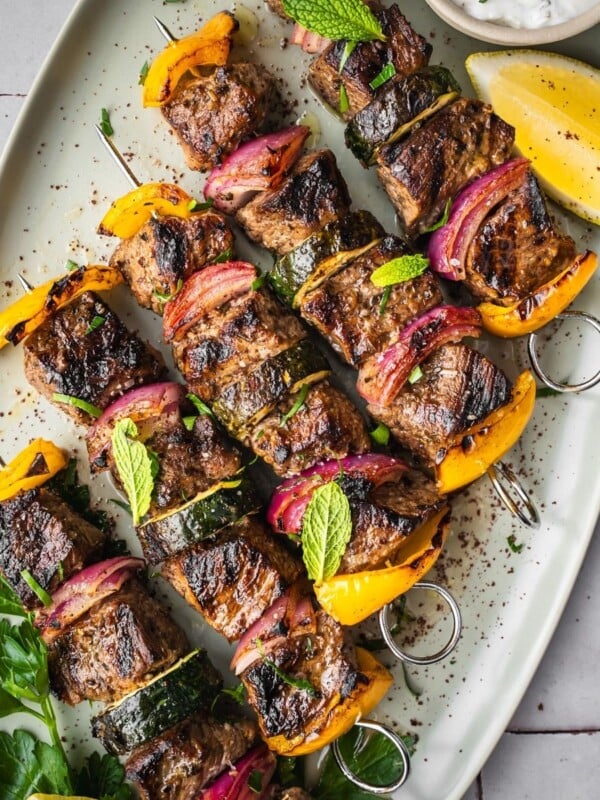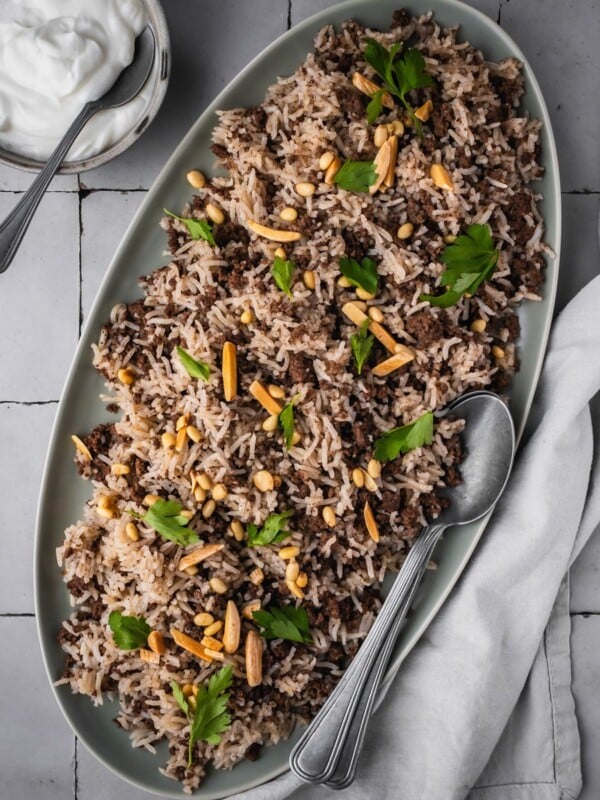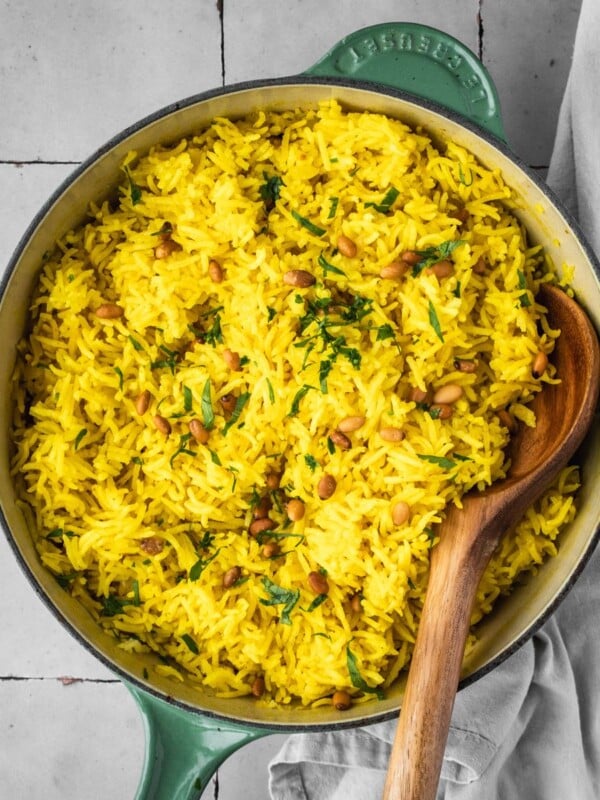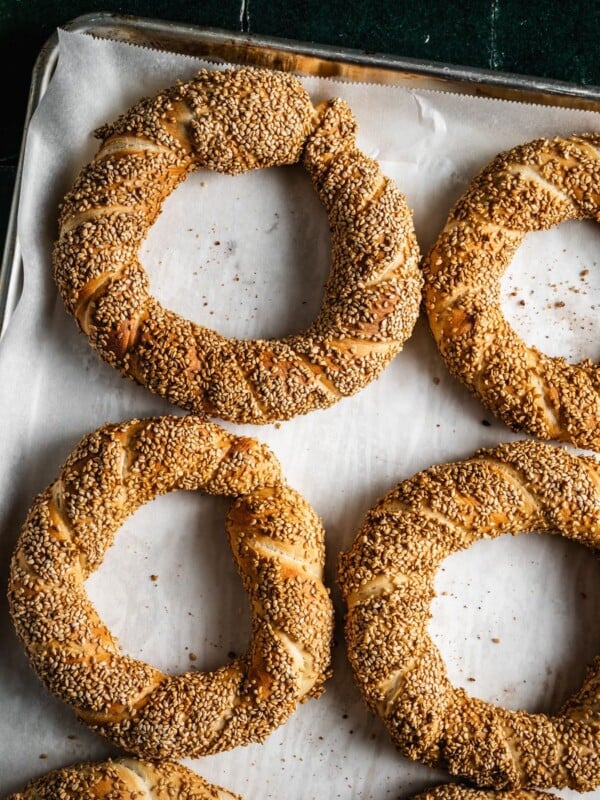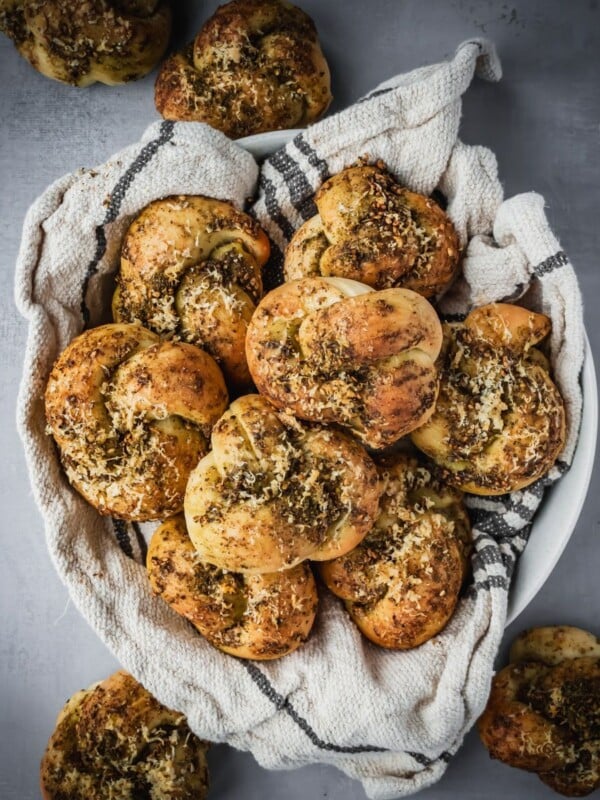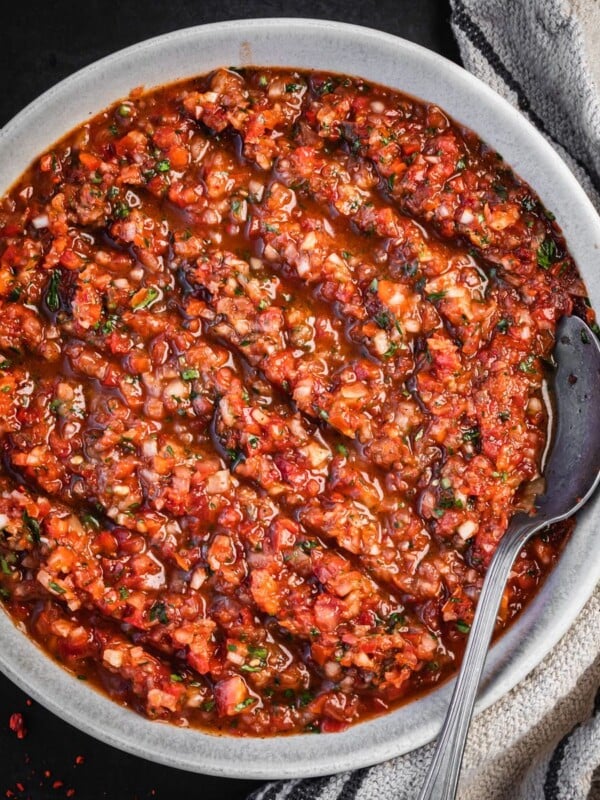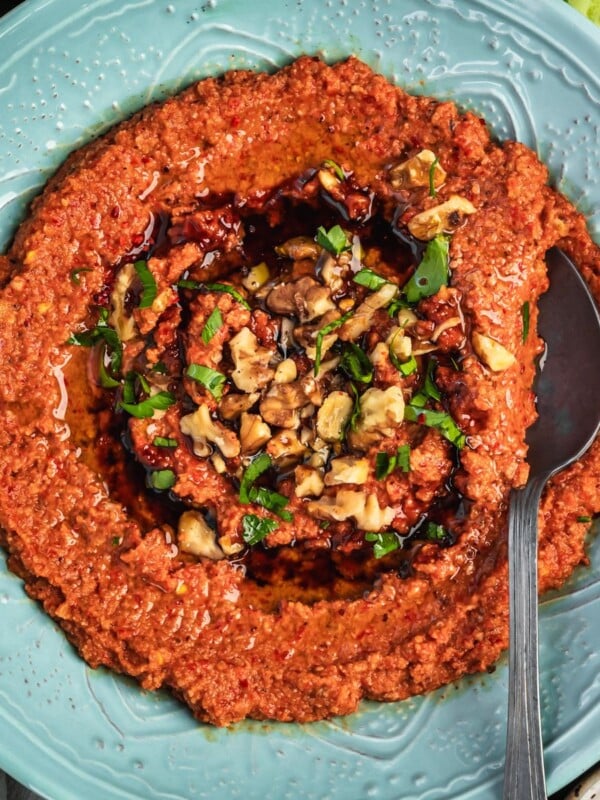Knafeh is a Middle Eastern Sweet Cheese Dessert that seems harder to make than it is! It’s cheesy, sweet, crunchy and delicious. A feast for the senses. This recipe is for the traditional coarse variety of knafeh.

Table of Contents
What is Knafeh?
Knafeh (also spelled kunafa, knafa, and knafah) is a traditional Middle Eastern dessert made from shredded phyllo dough (kataifi), sweetened cheese, and a syrup made from sugar and rose water or orange blossom water. It is typically layered and baked until golden and crispy on the outside, while the stretchy cheese inside becomes warm and gooey.
Originating from the Levant region, particularly Palestine, Jordan, Lebanon, and Syria, knafeh has a rich history dating back centuries. It is believed to have been created in the city of Nablus in the West Bank.
Over time, it has become a beloved dessert across the Middle East and beyond, with variations in ingredients and preparation methods found in different regions. It is a staple of Levantine cuisine.

Knafeh is often enjoyed during special occasions, religious celebrations (it is an important Ramadan recipe), and family gatherings. It holds a special place in the culinary traditions of the Middle East. Its unique combination of textures and flavors, along with its cultural significance, has made it a cherished dessert enjoyed by many around the world.
This will be the perfect dessert to end a Middle Eastern meal. For ideas on what to serve before it, check out my 9 Traditional Palestinian Recipes. You will also find some great ideas on my Levantine Appetizers and Levantine Main Dishes pages.
What’s the difference between coarse (Khishneh) and fine (Na’ameh) knafeh?
There are typically two types of knafeh. The coarse (khishneh) variety is made with kataifi (shredded filo dough). Fine (na’ameh) knafeh is made using semolina flour. Both are different yet similar. I enjoy both of them. This recipe is for the coarse variety, which in my opinion is easier to make especially for beginners.
The famous Knafeh Nabulsieh (from the town of Nablus in the West Bank, Palestine) is a fine (na’ameh) variety.
Ingredients
There are some specialty ingredients needed for this recipe, so make sure to read the ingredient notes below for more information.

- Kataifi: Kataifi is a shredded filo dough that’s typically compacted into a log. You will find it in the freezer section of any Middle Eastern grocery store. You will probably find it in a Greek grocery store too. This is essential to the recipe, there are no substitutions.
- Cheese: There are many different recipes that use a combination of cheeses. I like using a combination of Akkawi cheese and fresh mozzarella cheese. Akkawi is easy to find these days. It’s available at all Middle Eastern grocery stores and even some Costco locations. You will need to soak it in water to remove the salt content. Fresh mozzarella is easy to find too. It is usually sold in a tub with brine.
- Rose Water and Orange Blossom Water: You guessed it! These essential Middle Eastern ingredients can be found at your local Middle Eastern market, or even online. Some people use rosewater, others use orange blossom water. I like using both.
- Nuts: Many Levantine and Middle Eastern desserts are garnished or prepared with pistachios. For this recipe, a little bit of ground pistachios is used as garnish and to provide a pop of color. You can use ground almonds if you prefer.
See the recipe card for full information on ingredients and quantities.
How to Make this Knafeh Recipe
This isn’t a complicated recipe, but there are a few steps that I would recommend you read through first before starting.

Step 1. Prepare the scented sweet syrup. To a small saucepan, add the water and sugar (Image 1). Bring to a boil. Once the sugar is dissolved, add the lemon juice, rosewater and orange blossom water. Set aside to cool to room temperature (Image 2).

Step 2. Soak the cheese. Cut the cheese into small cubes and place in a large bowl (Image 3). Add cold water to the bowl and soak for 15 minutes (Image 4). Drain the water refill the bowl with fresh cold water and soak for 15 more minutes and drain. Repeat the process 3-4 times until the cheese is no longer salty. Drain and place the cheese in a paper towel-lined bowl (Image 5).

Step 3. Shred the kataifi. Thaw out the kataifi brick on a cutting board (Image 6). Using a sharp knife, cut it into large chunks (Image 7). Add the kataifi chunks to a food processor (Image 8). Process until the kataifi is shredded into a fine crumble (Image 9).

Step 4. Add butter to kataifi. Melt the butter in a small saucepan (Image 10). Transfer the shredded kataifi to a large mixing bowl. Coat it with the melted butter and using your hands rub it in to ensure all the strands are coated in butter (Image 11).

Step 5. Assemble. Preheat your oven to 350F. Butter your baking dish, baking pan or pie dish on the bottom and sides and add half of the buttered kataifi. Press down as firmly as you can to create a level and compacted layer (Image 12). Add the cheese, making sure to leave an edge of about half an inch (Image 13). Add the remaining kataifi to the sides and on top of the cheese, pressing down to form an even layer (Image 14).

Step 6. Bake and serve. Bake in a preheated oven for 40-45 minutes until the top is golden brown (Image 15). Set aside to cool for 10 minutes and then carefully invert onto a serving platter. Pour half the syrup all over the knafeh, saving the rest for your guests to use as needed. Garnish with crushed or ground pistachios (Image 16). Serve the warm knafeh with mint tea.
Expert Tips
- Soak the cheese! Don’t skip or rush this step. Some cheeses will take longer to shed their salt, so make sure to keep changing the water and taste the cheese as you go.
- Make individual portions. Rather than making a large knafeh, you can use ramekins to prepare individual portions.
Recipe FAQs
Kataifi is a type of shredded pastry dough that is popular in various Middle Eastern and Mediterranean cuisines. It is made from shredded filo pastry. The strands are typically used to wrap around various fillings such as nuts, cheese, or sweet ingredients like honey and sugar syrup. Used in recipes like Knafeh and baklava.
Yes, you can make the simple syrup 3 days in advance. Store it in a bottle, mason jar, or glass container in your fridge.
You can prepare and assemble the knafeh a day in advance. Store the unbaked knafeh in the fridge, covered with plastic wrap. Bake it an hour before you wish to serve it. Cheese-based desserts are best served right away or else the cheese may harden.
Store leftover knafeh in an airtight container in the fridge for up to 3 days. You can reheat in the microwave or a toaster oven.
Red food coloring is traditionally used to color the shredded kataifi. I don’t think it’s needed or makes a difference so feel free to omit it.

Other Levantine Recipes
Main Dishes
Levantine Recipes
Levantine Recipes
Appetizers
If you make Knafeh (Authentic Middle Eastern Sweet Cheese Pastry Recipe) or any other Levantine Recipe on Urban Farm and Kitchen, please take a moment to rate the recipe ⭐⭐⭐⭐⭐ and leave a comment below. It’s such a help to others who want to try the recipe.
For more Urban Farm and Kitchen, follow along on Instagram, Facebook, and Pinterest, visit the Urban Farm Shop, or subscribe for new posts via email.
Knafeh (Authentic Middle Eastern Sweet Cheese Pastry Recipe)
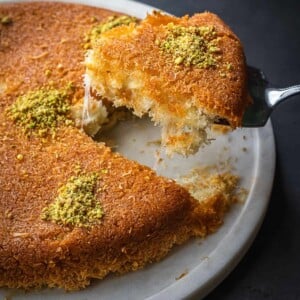
Equipment
- Round or square baking dish Choose one with low sides to make it easier to flip. I like using a round tatin pan or shallow pie plate.
Ingredients
- 1 cup Sugar – 200 grams
- ¾ cup Water – 180 ml
- 1 tsp Lemon juice – 5 ml
- 1 tsp Rosewater – 5 ml
- 1 tsp Orange blossom water – 5 ml
- 1 lb Cheese Mixture – Akkawi and fresh mozzarella (450 grams total), See Note
- 1 lb Kataifi – 1 package (454 grams), See note
- 8 ounces Unsalted Butter – 2 sticks or 12 tablespoons or 225 grams
Instructions
- Prepare the scented syrup. To a small saucepan, add the water and sugar. Set on medium-high heat and bring to a boil. Once the sugar is dissolved, turn off the stove, add the lemon juice, rosewater and orange blossom water. Set aside to cool completely.
- Soak the cheese. Cut the cheese into small pieces and place them in a large bowl. Add cold water to the bowl and soak for 15 minutes. Drain the water refill the bowl with fresh cold water and soak for 15 more minutes and drain. Repeat the process 3-4 times until the cheese is no longer salty. Drain and place the cheese in a paper towel-lined bowl.
- Shred the kataifi. Thaw out the kataifi brick on a cutting board. Using a knife, cut it into large chunks. Add the kataifi chunks to a food processor. Process until the kataifi is shredded into a fine crumble.
- Add butter to kataifi. Melt the butter in a small saucepan. Transfer the shredded kataifi to a large mixing bowl. Coat it with the melted butter and using your hands rub it in to ensure all the strands are coated in butter.
- Assemble. Preheat your oven to 350F. Butter your baking dish on the bottom and sides and add half of the buttered kataifi. Press down as firmly as you can to create a level and compacted layer. Add the cheese filling, making sure to leave an edge of about half an inch. Add the remaining kataifi to the sides and on top of the cheese, pressing down to form an even layer.
- Bake and serve. Bake in a preheated oven for 40-45 minutes until the top is golden brown. Set aside to cool for 10 minutes and then carefully invert onto a serving platter. Pour half the cooled syrup all over the knafeh, saving the rest for your guests to use as needed. Garnish with crushed or ground pistachios.
Notes
- Kataifi: Kataifi is a shredded filo dough that’s typically compacted into a log. You will find it in the freezer section of any Middle Eastern store.
- Cheese: There are many different recipes that use a combination of cheeses. I like using a combination of Akkawi cheese and fresh mozzarella. Akkawi is easy to find. It’s available at all Middle Eastern grocery stores and even some Costco locations. You will need to soak it in water to remove the salt content. Fresh mozzarella is easy to find too. It is usually sold in a tub with brine.
- Rose and Orange Blossom Water: These essential ingredients can be found at your local Middle Eastern market, or even online. Some people use rosewater, others use orange blossom water. I like using both.
- Nuts: Many Levantine and Middle Eastern desserts are garnished or prepared with pistachios. For this recipe, a little bit of ground pistachios is used as garnish and to provide a pop of color. You can use ground almonds if you prefer.
Nutrition
Nutrition information is automatically calculated, so should only be used as an approximation.
 Like this recipe? Rate & comment below!
Like this recipe? Rate & comment below!